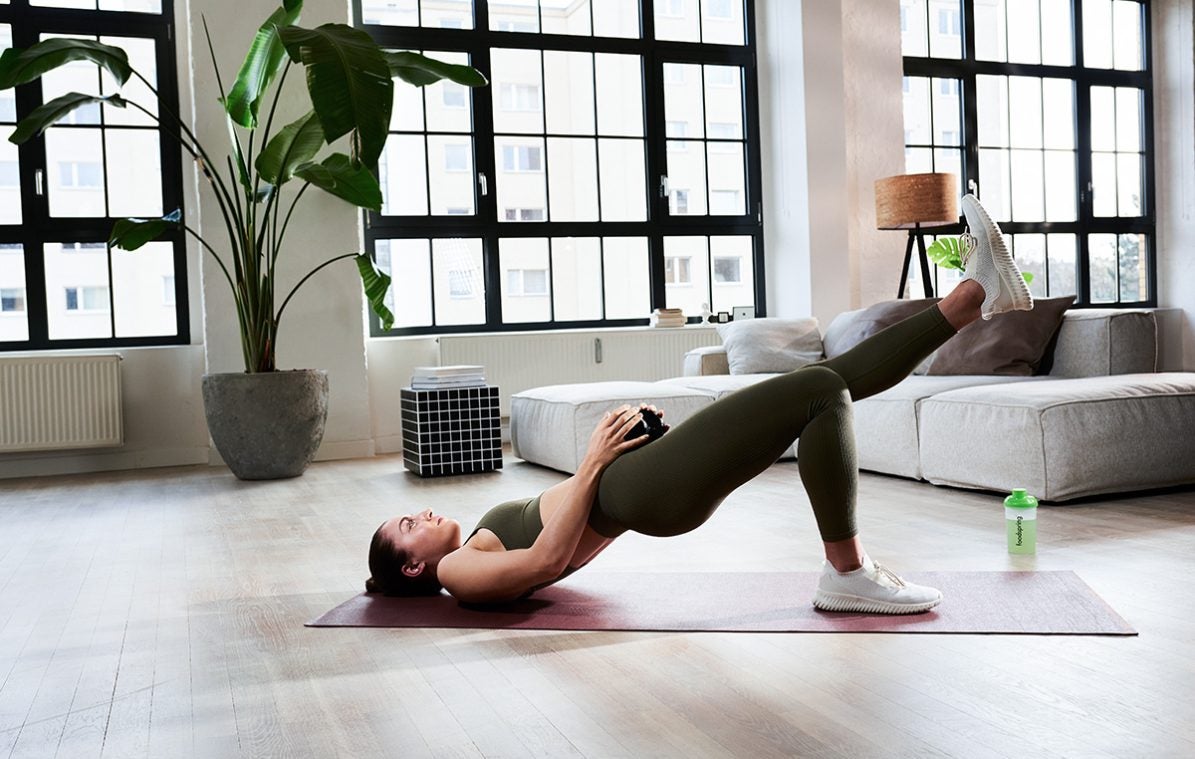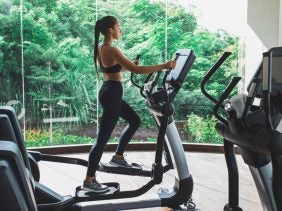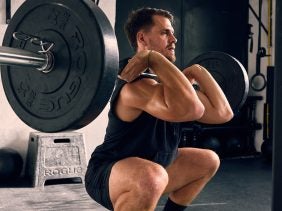Glute Exercises for a Solid Behind
 ©foodspring
©foodspring
Did you know that the gluteus maximus is the largest and most powerful muscle in the body? Those of us with desk jobs are used to sitting on our duffs for, let’s face it, too many hours of the day. But the glutes do so much more. For people who don’t have mobility differences, the glutes are the muscle that allows walking, running, jumping, and so many other sports (skiing, snowboarding, skating, horseback riding). And if you love deadlifting, cleans, back squats, and more, you now you have your glutes to thank.
Related: Feel your best with these easy mobility exercises
The butt is made up of three muscles. The (large) gluteus maximus, the (medium) gluteus medius, and the (small) Gluteus minimus). The gluteus maximus is mostly responsible for hip extension and stabilizing the thigh in extension and external rotation. It also keeps your pelvis from tilting forward. The gluteus medius, along with the small gluteal muscle, is primarily involved in abduction, or spreading your legs outward. The small gluteal muscles are also essential when walking. For example, they keep your pelvis from collapsing into your lifted leg.
Refuel: Try our energy bars
Why is it so important to have a strong butt?
Ever heard of the expression “lazy butt?” There’s some truth to it. Sitting in front of the computer all day, or spending long stretches in the car, can actually make your butt weaker. As a result, other muscles compensate. The lower back, thighs, and nearby muscles may end up overdeveloped, and this incorrect distribution of work can cause strain, misalignment, injury, and pain. It’s also why many people find it difficult to properly target their glutes during a workout. It’s harder to activate a muscle that gets underused.
Weak glutes can also contribute to poor posture—especially if the deficit is from sitting a lot, which shortens your hip flexors. And on the other hand, having strong glutes make all parts of your life better. Lifting anything heavy, whether it’s a barbell or a bag of soil, is easier. Runners, cyclists, skaters, even swimmers benefit from strong glutes.
So if you’re dealing with an injury, it could be that the real problem resides in your butt. “Weakness of GM has been implicated in numerous injury types such as anterior knee pain, anterior cruciate ligament [ACL] injuries, low back pain, hamstring strains, femoral acetabular impingement syndrome [a hip joint irregularity], and ankle sprains,” write researchers from the FIFA Medical Centre of Excellence. “And its weakness/dysfunction may be a contributing factor to or the result of injury.”
So we’ve got a bunch of moves that’ll make your glutes strong and resilient. And if you want more ways to get your health in line, try our Body Check.
How to do this workout
Start your session by doing an activation move which ensures your glutes are firing properly. Lie on your stomach with legs extended behind you, sternum resting on hands, hands stacked, palms down, gaze toward floor. Maintaining a straight leg, and flat pelvis, lift left leg quickly until you reach a sticking point, hold for a moment, then slowly lower without touching floor. Repeat 19 times, then return to start. Switch sides.
Then do a set of glute bridges, which are also great for activation. Lie on floor, knees bent, feet on floor, to start. Press through heels and raise hips toward ceiling until your body creates a straight line between shoulders, pelvis, and knees. Then return to start.
Related: Your 30 day booty workout for strong glutes
The moves
1) American hip thrusts
Start with shoulder blades on the edge of a bench, feet on the floor shoulder width apart, toes pointed slightly to sides, a barbell (loaded or unloaded) across hips. Press through heels and raise hip, activating glutes to move the bar, until thighs and shins form a right angle at the knee, squeezing butt at top. Lower to start for one rep. Do 3 sets of 8 to 10 reps.
2) Deadlifts
Start standing shoulder-width apart, a barbell (loaded or unloaded) just over toes, hands holding bar just wider than shoulder width apart, hips hinged, back flat, squeezing shoulder blades back and down, gazing in front of you. Activate hips and press them forward and up while pushing knees out. Lift until legs and hips are locked out. Do 3 sets of 8 to 10 reps. If your gym has a hex bar, try using that for additional glute activation.
Refuel: Try our whey protein
3) Standing hip adductions
Stand with a short resistance band, light to medium resistance, around thighs, knees soft, hands on hips, shoulder blades back and down. Start by shift weight onto left leg and slowly raise right leg to the right side as far as possible while maintaining balance. Reverse to start for one rep. Do 3 sets of 15 reps. Complete reps on one side before switching sides. If needed, lightly hold a wall or rig for balance.
4) Single-leg glute bridges
Do the same glute bridges as in the warmup, except extend one leg at a time while performing reps. Do 3 sets of 15 reps. Complete reps on one side before switching sides.
Looking for more ways to challenge your glutes? A 2020 review of research published in the Journal of Sports Science and Medicine identified 21 exercises that do the most for glute activation and strength.
| Traditional Barbell Hip Thrust | Very high |
| American Barbell Hip Thrust | Very high |
| Belt Squat | Very high |
| Split Squat | Very high |
| In-line Lunge | Very high |
| Traditional Lunge | Very high |
| Pull Barbell Hip Thrust | Very high |
| Modified Single-leg Squat | Very high |
| Traditional Deadlift | Very high |
| Band Hip Thrust | Very high |
| Parallel Back Squat | High |
| Feet-away Barbell Hip Thrust | High |
| Front Squat | High |
| Stiff-Leg Deadlift | High |
More healthy living tips from foodspring:
- More performance in the gym through mobility training
- The #1 Reason Your Muscles Aren’t Growing
- 6 Surprising Effects Lifting Weights, According to Science
- Push & Pull – The Only 6 Moves Your Need to Know to Build Strength
Sources for this article
We at foodspring use only high-quality sources, including peer-reviewed studies, to support the facts within our articles. Read our editorial policy to learn more about how we fact-check and keep our content accurate, reliable, and trustworthy.

































